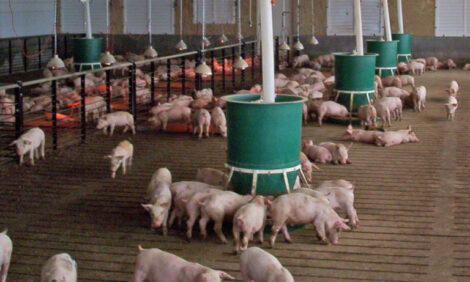



Monthly Review of the U.S Hog Market - May 2001
Our Monthly look at the trends in US Hog Market and what effect these may have on future prices. Hog Slaughter Jumps, Imports Down, Exports Up, Where Have All The Hog Price Quotes Gone? Written by James Mintert, Kansas State University.
Hog Slaughter Jumps
Hog slaughter has increased substantially in recent weeks. During January March commercial hog slaughter declined 1.8% compared to the year ago quarter. But hog slaughter during April climbed to a daily average of 369 thousand head, nearly 4% greater than April 2000. Based upon the March Hogs and Pigs report, commercial hog slaughter during the April June quarter was expected to rise above last year's by 1.5 to 2%.Some of the recent slaughter increase could be attributable to this past winter's weather delaying marketings from winter to early spring. But if slaughter continues at these levels much longer, it suggests that the pig crop September-November pig crop estimate published on the March report was underestimated.
Imports Down, Exports Up
Pork imports declined over 9% during February compared to February 2000. And for the first two months of the year, pork imports fell nearly 5% below January-February 2000. Declines in pork imports from both Canada and Denmark were the principal reasons pork imports declined.At the same time pork imports were declining, pork exports rose. Total pork exports increased over 14% during February compared to a year ago and for January-February combined, pork exports rose 18% compared to 2000. Through February, pork exports to Japan (+29%) Canada (+8%), and Mexico (+38%) were all up substantially.
The dramatic improvement in pork trade flows was somewhat of a surprise. Given that beef exports were down at the same time pork exports were increasing, it looks like importing customers shied away from relatively high priced beef which posted record high boxed beef cutout values during January, in favor of lower priced pork.


Where Have All The Hog Price Quotes Gone
Obtaining hog price quotes that represent the bulk of the hog trade recently has been difficult. Because of technical difficulties, USDA did not routinely report prices for the Iowa-S. Minnesota market during much of April.That problem appears to have been rectified during the first week of May as USDA finally started to publish Iowa price quotes again. But it's still not clear how quotes published under Mandatory Price Reporting compare to price quotes published under the old voluntary price reporting system since the quality specifications have changed.
For example, USDA's Iowa Daily Direct Prior Day Hog Report issued May 4, 2001 indicated that the weighted average base price was $65.90 per carcass cwt. (i.e., approximately $48.75 to $49.50 per live cwt.) for hogs with a 185 pound carcass, 0.9 to 1.1 inches of backfat, with a loin area of 6 sq. inches and a loin depth of 2 inches. This appears to be about 5 to 6% below year ago price quotes, but it's not clear the quality specification has been held constant over this time period.
In contrast, USDA's 5 day average estimate of pork cutout values (which did not fall under the Mandatory Price Reporting rules) through May 3 was $69.32, approximately 2% below a year ago. The rise in hog slaughter during April has been felt in the wholesale market as the pork cutout value has declined from a weekly average of $72.06 at the end of March to this week's $69.32, a decline of 3.8%.
Mandatory Price Reporting Update
Mandatory Price Reporting (MPR) was implemented by USDA's Agricultural Marketing Service (AMS) on April 2, 2001. Given the complexity of the transition from the old voluntary reporting system, which had been in place for decades, to the new mandatory system, it's not surprising that there have been a large number of problems. It appears that price information made available under the new reporting system will continue to evolve for some time.The single biggest problem with the transition to MPR has been the lack of information made available by AMS under the new system. Market participants and analysts accustomed to receiving updated regional price reports for both slaughter cattle and market hogs one or more times per day have been frustrated by the large number of times reports have contained one of the following phrases: "Confidentiality of data prevents publication of this report under Livestock Mandatory Reporting" or "Technical problems prevent publication of this report".
The result in the short run was a price reporting system that made less, rather than more, pricing information available to the public. And some market participants resorted to use of private firms providing market news services such as Cattle-Fax, and Urner-Barry's Yellow Sheet since they were free to report prices they obtained via a variety of sources and did not have to deal with any of the restrictions imposed by MPR.
Time heals all wounds, or so the saying goes, and as time passed during April AMS made more and more MPR reports available. Technical problems were most pronounced in the hog sector, which prevented AMS from routinely publishing the Iowa-S. Minnesota hog price report. Apparently, the problem revolved around AMS' inability to sort through and properly aggregate the myriad price reports received from packers. However, by early May AMS was again issuing Iowa-S. Minnesota hog price reports. Similarly, there were more cattle price reports available in early May than in early April, but regional price reports in particular continue to be issued infrequently.
One culprit for a lack of price reports, especially in both the cattle and sheep markets, has been the "3/60 Guideline" which limits AMS ability to issue price reports. The "3/60 Guideline" states "Submitted information will only be published by USDA if: (a) It is obtained from no fewer than 3 packers or importers representing a minimum of three companies; (b) the information from any one packer or importer represents not more than 60 percent of the information to be published; and (c) AMS does not have any reason to believe the information cannot be reported in a manner that protects the confidentiality of the source packer."
Fundamentally, the 3/60 guideline is designed to protect the confidentiality of information submitted by individual firms under MPR. Unfortunately, implementation of the rule has meant that price reports are not routinely issued for a variety of different markets, such as regional cattle markets. Importantly, price reports for many of these same markets were routinely published by AMS under the old voluntary price reporting system. So, in the short run, MPR has come to mean less, rather than more, price information in some markets.

There appears to be widespread agreement within the industry and at AMS that the "3/60 Guideline", as it's currently interpreted by AMS, is unworkable. Fortunately, the "3/60 Guideline" is just what it says it is, a guideline.
The rule was developed partly based on a request from the Office of Management and Budget (OMB) that AMS have a firm guideline to use in determining what information could be released and what could not be released, and still be consistent with the underlying legislation.
Preliminary discussions regarding possible changes have focused on allowing one firm to represent as much as 80 percent of the price information on a particular report or, possibly, allowing AMS staff to exercise some judgment regarding when confidentiality requirements might be violated, which would preclude publication of a particular report. At this point it's too soon to tell which direction changes at AMS will go or how quickly changes will be implemented.
Interpreting The New Reports
The new reports provided by AMS are not simply new "mandatory" versions of the old voluntary price reports and that has also generated some confusion. In particular, most of the new reports have the potential to provide more detailed information regarding prices paid for various weights of livestock and various quality levels.For example, new mandatory price reports now provide a more accurate price report for high quality (80% or more Choice) cattle vs. lower quality cattle (i.e., 35-65% Choice and less than 35% Choice). Similarly, hog price reports now provide pricing information by carcass weight, fat depth, loin eye area, loin depth. But, in the case of hogs, it is still difficult to determine what price the bulk of the hogs traded at on a given day in the Western Corn Belt, Iowa or other regional markets, which is a price that would be more comparable to the price reports available under the old voluntary pricing system. This issue is likely to be resolved soon as AMS learns to deal with the large volume of pricing information received from packers.
Futures Based Cash Price Forecasts
Futures prices, adjusted for basis expectations, are a source of continuously updated cash price forecasts. As an example, Western Corn Belt 51-52% lean barrow and gilt price forecasts based upon futures prices at the time of this writing (5/3/01 settlement prices) adjusted for basis expectations are included in a graphical format. Basis forecasts are based upon the most recent three-year average basis for 51-52% lean barrows and gilts.To provide some indication of the amount of risk present, forecasts based upon the most positive and negative basis of the last three years are also included. Weekly updates (in graphical form) of these price forecasts are also available on the K-State Livestock & Meat Marketing Web Site (www.agecon.ksu.edu/livestock) in the weekly electronic publication entitled Hog Price & Supply Graphs.

Information Provided by KSU Livestock report. For more information visit the KSU Livestock website.








